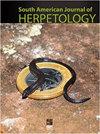妊娠对巴西东南部南美响尾蛇Crotalus durisus体温的影响
IF 0.7
4区 生物学
Q4 ZOOLOGY
引用次数: 1
摘要
摘要在鳞类爬行动物中,生殖雌性体温(Tb)的变化有很好的记录。然而,这些变化的方向因物种而异。与未怀孕的女性相比,怀孕的女性可能表现出更低或更高(且变化较少)的结核病。在某些物种中,怀孕对雌性结核病没有可检测到的影响。在本研究中,我们比较了不同生殖状态(怀孕和未怀孕)的雌性响尾蛇(Crotalus durissus)的Tb,以探讨怀孕是否影响Tb。我们测量了2016年夏季和春季以及2017年夏季在半自然室外围栏中饲养的雌性响尾蛇的Tb。怀孕的女性比未怀孕的女性选择更高的平均结核。此外,我们发现结核在不同季节之间存在显著差异。2017年夏季的体温高于其他季节;然而,生殖状况不影响结核变异。因此,我们的研究结果与雌性在怀孕期间改变体温调节行为的假设一致。雌性响尾蛇可能会在怀孕期间增加其Tb,以提高后代的适应性或最大化其终生适应性。本文章由计算机程序翻译,如有差异,请以英文原文为准。
Effects of Pregnancy on the Body Temperature of the South American Rattlesnake, Crotalus durissus, in Southeastern Brazil
Abstract. Changes in the body temperature (Tb) of reproductive females are well documented in squamate reptiles. However, the direction of these changes varies among species. Pregnant females may exhibit a lower or higher (and less variable) Tb than nonpregnant females. In some species, pregnancy has no detectable effect on female Tb. In this study, we compared the Tb of female rattlesnakes (Crotalus durissus) in different reproductive statuses (pregnant and nonpregnant) to investigate whether pregnancy influences Tb. We measured the Tb of female rattlesnakes kept in a semi-natural outdoor enclosure during summer and spring 2016 and summer 2017. Pregnant females selected a higher mean Tb than nonpregnant females. Moreover, we found significant differences in Tb among seasons. Body temperatures in summer 2017 were higher than in other seasons; however, reproductive status did not influence Tb variance. Therefore, our results agree with the hypothesis that females change their thermoregulatory behavior during pregnancy. Female rattlesnakes may increase their Tb during pregnancy to increase offspring fitness or to maximize their lifetime fitness.
求助全文
通过发布文献求助,成功后即可免费获取论文全文。
去求助
来源期刊
CiteScore
1.50
自引率
0.00%
发文量
10
期刊介绍:
The South American Journal of Herpetology (SAJH) is an international journal published by the Brazilian Society of Herpetology that aims to provide an effective medium of communication for the international herpetological community. SAJH publishes peer-reviewed original contributions on all subjects related to the biology of amphibians and reptiles, including descriptive, comparative, inferential, and experimental studies and taxa from anywhere in the world, as well as theoretical studies that explore principles and methods.

 求助内容:
求助内容: 应助结果提醒方式:
应助结果提醒方式:


